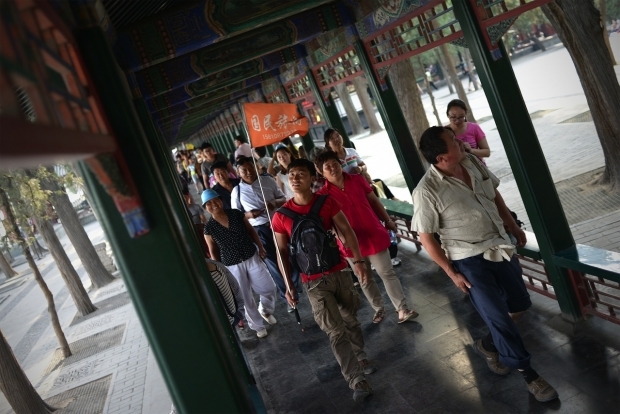Recent news stories and industry studies show that fewer international visitors are choosing China as their destination. January-June arrivals in Beijing are down 15% from the same period in 2012 and more Chinese than ever before are spending their money to travel abroad, “opting out” rather than exploring their vast and varied home country. All this prompted us to ask today’s question of a handful of thinkers deeply involved in travel and looking at travel.
Leah Thompson: I’ve posed for photographs in front of the Eiffel Tower, walked the Great Wall with thousands of tourists, and even reluctantly sat through a carriage ride in Central Park—but most of my tourism is of the off-the-beaten-track variety, a kind of travel completely discouraged by the Chinese government. Even deep in rural China, where you might expect to find a unique experience, the UNESCO heritage village of Hongcun, in East China's Anhui province, feels less alive than it does like Disneyland featuring massive tour bus parking lots, ticketed entry gates and row upon row of souvenir stands.
Even as China’s growing cities continue to bulldoze traditional houses and neighborhoods to make room for skyscrapers at record speed, parts of the government have developed a deep appreciation for the role cultural heritage can play in forming national identity and boosting tourism and GDP. During the 1990s, the development of domestic tourism became a major government objective and led to the buildup of select destinations.
The majority of Chinese domestic tourism involves large groups, often wearing matching caps and following a guide with a flag, visiting designated “Scenic Spots.” Today, cultural heritage tourism remains a priority both at the national and local levels because it propagates the central government’s preferred historical narrative while serving as a source for local economic development. By promoting sites such as Hongcun or the Confucius Temple in Qufu, the current Chinese government aligns itself with China’s ancient past and gains authority as the legitimate protector of an unbroken 5,000-year-old Chinese civilization.
If China wants to attract more foreign tourists it needs to find ways to accommodate active travel and individualized experiences. It would seem some boutique inns and travel companies are beginning to understand the increasing desire among both foreign and domestic tourists to experience something authentic. The first step in this direction requires cleaning up the environment. As China’s pollution is at crisis levels, it’s worth reiterating that all tourism suffers if the air is too smoggy see anything from a scenic spot.
Damien Ma: Here are my top five, back-of-the-envelope ideas for further encouraging Chinese tourism to “developed countries,” particularly the United States. Some already are happening, and others are more far-fetched and deliberately tongue-in-cheek. But this kind of “opting out” of their own country by well-off Chinese, for various reasons, also reflects inadequacies and challenges in China’s own political economy.
1. Medical tourism (This already is happening to some extent with some Chinese mothers preferring to give birth in the United States or Hong Kong, reflecting in part the dire state of China’s own healthcare system.)
2. Florida in Five Days (This would appeal to Chinese retirees and also their children who have to shoulder the burden of taking care of them under a broken pensions and social welfare system. They can visit retirement home communities and hospices, and the tie-in would be potentially buying retirement homes for their parents.)
3. Detroit Property Galore (self explanatory, not to mention the sky high prices per square meter of floor space in a Beijing or Shanghai.)
4. From Napa to Williamette Valley (Many Chinese are trying to get into the wine business and establish Chinese wines as global brands, former NBA star Yao Ming included. This would appeal to many Chinese who are becoming oenophiles.)
5. Montgomery and Fairfax County Public Schools Tour (The hyper competitive school entrance environment in China and elite parents’ increasingly changing attitude on Chinese pedagogy means that for those who can afford it, they are more likely to opt out of the system. They want to send their kids abroad as early as high school. And Montgomery and Fairfax counties have some of the best public high schools in the United States.)
Christine Lu: From a consumer marketing point of view, China needs to do a better job of branding itself across the board in a way that connects with the various interests of today’s global traveler. Like many tourism destinations, there are areas worth exploring that extend beyond the country’s traditional focus on famous landmarks. For those who have visited once to take an obligatory photo of themselves on the Great Wall or in front of Pudong’s skyline, what else does China have to offer on a return visit? People’s motivations for travel today are very diverse.
I see an opportunity in attracting both first time and repeat visitors by focusing on niche markets. There’s a side of China that self-proclaimed “foodies” who travel to eat absolutely love. What about the art collectors who follow the emergence of China’s new creative class? How about the adventure seeker who wants to backpack around the country? China has long attracted these types of travelers by word of mouth from friends who have visited before or through independent research of travelers with a niche interest. As a result, much is written in personal blogs and articles in travel magazines if one wants to take the time to search. However, I think a better effort could be made on the part of China’s tourism sector to brand the country in a way that incorporates these niche interests into its tourism campaigns overseas.




